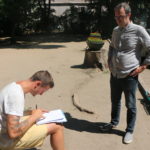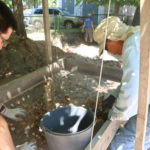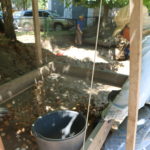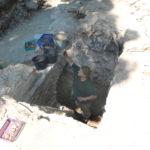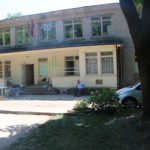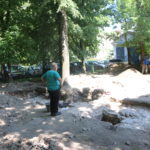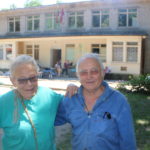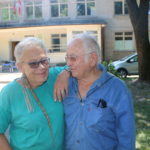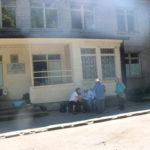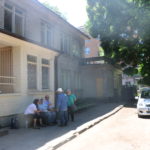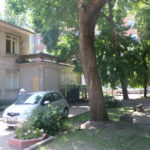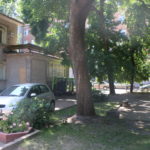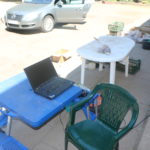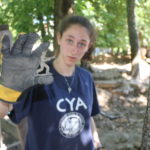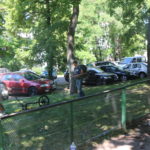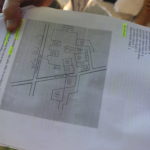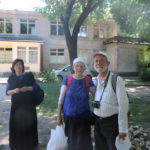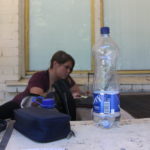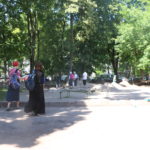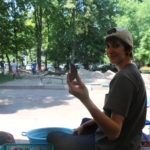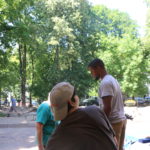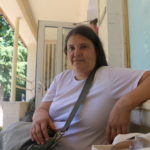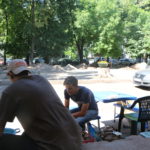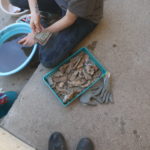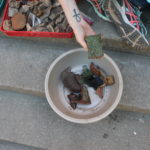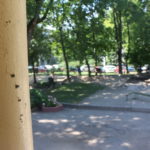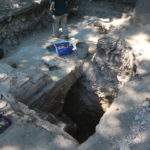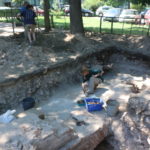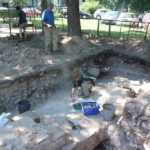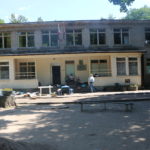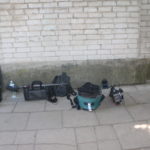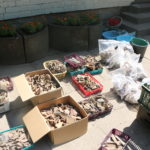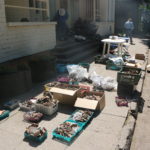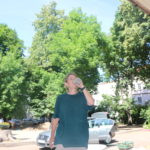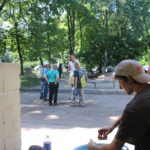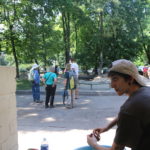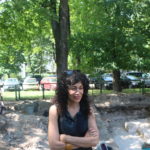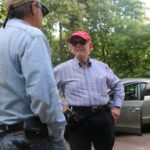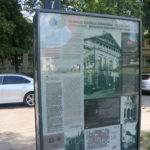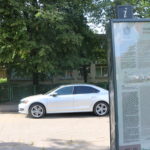
by Geoff Vasil
“Don’t get too close!” an attractive and sunburned young Lithuanian warned at the edge of a large pit just behind what was the Great Synagogue of Vilnius. He’s friendly and it quickly becomes clear he’s the lead archaeologist on the dig, but he’s just as quick to point out he’s formally the lead archaeologist, but Dr. Richard Freund of the University of Hartford in Connecticut is the real force behind the whole initiative.
Mantas Daubaras is doing his doctoral thesis at the Lithuanian Institute of History on a Neolithic site far to the west in Lithuania. He has no personal connection to Jewish Vilna and approaches it as he would any site, dispassionately.
“Yesterday we found what we think is the ritual bath,” he explains, pointing to a small hole in the top of what looks like a vaulted brick ceiling. They sent a camera in to take a look and found a large space terminated by rubble and fill. Does it connect to the Great Synagogue? He doesn’t know yet, but it looks as if it extends right up to the line where they think the back wall of the synagogue once stood.
“Last year we did preliminary non-invasive surveys using ground-penetrating radar and other methods. We detected an anomaly right here,” he says, pointing to an area behind the single missing brick in the ceiling of the subterranean mikveh. Is it something metallic? “Not necessarily,” he says, “We just call it anomalous.”
The Great Synagogue once stood at the center of Jewish life in Vilnius. Built mainly under ground so as not to tower over neighboring churches and offend Christian sensibilities, it was a vast space at the center of a complex of buildings roughly located in the area of the Vilna Gaon’s “kloiz,” or beth midrash, house of study. Besides the kloiz, the ritual bath facility or mikveh and synagogue itself, there was also the Strashun Library in front of the synagogue and an area off to the side said to be the Vilna Gaon’s home, although the location of the “Gaon’s synagogue” was probably notional more than historical, and long before the Holocaust.
In 1941 the Nazis and Lithuanian collaborators established a ghetto for the Jews scattered throughout Vilnius, first by “clearing” (murdering) an entire street mainly inhabited by Jews near the Shulhoyf. This began with the Great Provocation, a play on the name of the street where it happened, Veliki in the Slavic languages, Didžioji in Lithuanian. The area became the first ghetto in Vilnius, including the synagogue and surrounding buildings, and after the second ghetto was established across German Street, the smaller first ghetto became a place to put the elderly and infirm culled from the larger population. It was quickly “liquidated,” meaning all its inhabitants were carted or marched off to Ponar, shot and left in the pits there. Many hid in the first ghetto, and Herman Kruk describes the carnage after the Nazis and Lithuanians went through to “mop up” the remnant population.
After the “liquidation,” the first ghetto was left abandoned and separated from the city, except for a few forays by the group led by Kruk used by the Rosenberg Task Force engaged in looting the richer elements of Judaica in Eastern Europe.
Harry Jol, professor of geography at University of Wisconsin-Eau Claire, was present at the preliminary surveys last year, and led a group of 4 students from his university and one more from Clark University this summer at the dig. He explained how they used ERT—electrical resistivity tomography—in 2015, and detected the anomaly behind the supposed mikveh. Jol says it was magnetic, but whether it was rebar stuck in the concrete later cast in the area, or buried treasure, or something else, was anyone’s guess until they actually reached that layer in the digging. He said they took the results from a preliminary dig on the other side of the building now standing at the site in 2011, but only after they had done their own ERT surveys, and that results from both coincided nicely with what they believed were the outlines of the former buildings at the site, giving them a good idea of what lay where using period maps, drawings and photographs. “It was a real proof-of-concept” and showed they had correct ideas about the layout, he said.
The Great Synagogue was in an area which did receive aerial bombardment during the liberation of Vilnius by Soviet forces—once narrow German Street is now two lanes with a pedestrian mall in between because of the bombing and loss of entire buildings—but largely survived the war. In the early 1950s about half the building was still standing, without a roof and filled with rubble. The Soviet authorities decided to bulldoze the entire site and build a white brick primary school there. The school is still there. The principal, a middle-aged curly blonde woman, says school is out for summer and the archaeologists are only using the back steps and playground area as their base. But a team from the PBS television documentary series NOVA, from WGBH Boston, disappear regularly inside the school to talk shop among themselves.
Producer Owen Palmquist says they don’t have a title yet, but the working title is simply “Vilna.” He wants to do a full three-dimensional digital reconstruction of the Shulhoyf but is afraid the budget won’t allow it. “NOVA is a scientific program primarily, and so we are focusing on the archaeology rather than Jewish culture, “ he explains. He was in Vilnius last year and remembers some colleagues talking about how it might be possible Jews return to Vilnius someday and revive the small Jewish community here. There is something very attractive about Vilnius and Lithuania, for Jews and for gentiles, and some deep and abiding presence, he thinks out loud.
The Coopers from Israel are already busy working the dig, sifting and washing the finds. Varda is a Litvak on both her mother’s and father’s sides, and both sides of her family are from Vilnius. They left for Palestine in what she calls the third wave of Jewish settlement there, in the 1920s and 30s. A good decision. “But many of my relatives didn’t move, sadly,” she says, and looks off into the distance. Her husband Yankele, a retired Israeli tour guide, is just as proud of his Jewish roots in Ukraine and Romania and his blue eyes beam with friendship when he takes a break from moving earth under the hot June sun. Her younger sister Shuli is doing the majority of the work excavating what looks like the mikveh, and has begun removing earth from under an archway. Shuli isn’t just the most active digger on the site, she’s an archaeologist from the Israeli Antiquities Authority and exudes an air of real authority effortlessly, as part of her presence.
“I think I shouldn’t have washed this glass,” Varda tells prime mover Richard Freund on the steps of the grade school. “I think there might have been colors or paint on it.” Richard says these things happen.
The plastic bowls are filling up with bits of glazed tile, random pieces of metal, glass shards and a surprisingly large number of bones, which no one seems to understand. They are mainly chicken and cow bones.
Rachel Polinsky, part of Dr. Jol’s team of students but from Clark University in Worcester, Massachusetts, sifts a load of soil and finds a small metal toy soldier, green with age. She thinks it must be made of lead because of its palpable weight in her palm. The uniform is strange, from another time, perhaps a Hussar or Cossack outfit, but taking aim with a rifle. The students from University of Wisconsin are all occupied: Thomas and Alex are doing more ground-penetrating radar behind the school’s back fence, while Jackie Seamans is entering their data into an Excel spreadsheet back in the shade on the school steps to correct for topographical ground surface deviations. She has twisted her foot somewhere, probably on the uneven cobblestones and sidewalks of Vilnius, and can’t put much weight on it. Nicki Awad, a self-confessed Star Wars nerd who has actually been to Tataouine in Tunisia, the location used as Luke Skywalker’s home planet Tatooine in the first movie, is washing bone fragments and bits of tile next to Jackie. Mika Schuster, a restoration specialist from Israel, is also taking it easy on the back benches and sympathizes with Jackie, having done the same thing and eventually breaking her own leg, which seems to be fully mended now.
A group of Israelis drop by with professor Moishe Yitzhaki of Bar-Ilan University in town for a conference on information sciences. “It’s what used to be called library science,” he explains. “Since the internet changed everything…” An attractive Israeli woman named Pnina is insisting she just yesterday heard on Israeli radio the “Gaon’s synagogue” had been discovered in Vilnius. She recites the report from memory in Hebrew. Moishe is trying to find it on a map, which seems to show the mikveh in the wrong place, where the Gaon’s house is usually located. Eventually they get into a big conversation with Richard Freund, who explains it all to them. The Gaon’s synagogue either means the Gaon’s kloiz, or the Great Synagogue, whereas the discovery in the last few days was of the mikveh. They inspect the site, Pnina, Khaya and a younger relative, and all agree it really does look like a mikveh. Pnina wanted to travel to Tels, but was afraid it would be too difficult. Now that she’s in the country, it seems very possible, and she wants to go back to Israel and bring her son to Lithuania so they can go there together, to see where her father attended yeshiva. Pnina complains of the heat, but no one is sympathetic, saying it’s hotter in Israel.
The three-member NOVA film crew reemerge from the shadows just as Tsila Zak arrives. Tsila Zak is the Litvak architect who won the first contest way back in 1989 by the just-reconstituted Lithuanian Jewish Community under chairman Grigoriy Kanovich for commemorating the Great Synagogue site. A Vilnius Litvak on both sides, Zak was living in Stockholm then, and really didn’t want to submit an entry. Her mother had forwarded the information to her, but she felt it was too great a burden to take on, involving the entire Litvak people and their destruction in the Holocaust. At the last moment she had a change of heart and became convinced she must do something. She sent away for the full application package just a month before the deadline, and received one of those typical Soviet parcels, a large box wrapped in butcher paper, held together with twine. Inside they had sent her numerous actual photographs and other material about the Shulhoyf. Zak decided on the idea that a celebration of Jewish life made the Holocaust stand out all the more, and went for a simple design involving excavating part of the surviving space and commemorating with markers above at ground level. Her entry won, but as with so many cultural projects from that time, nothing came of it. She lived her life, moved from Stockholm to Tel Aviv where she eventually built back up her career as an architect and where she now lives, and then out of the blue in 2011 Vilnius mayor Artūras Zuokas contacted her by telephone with a plan to implement her Great Synagogue project.
In 2011 the Lithuanian government and the Vilnius municipality engaged archaeologists to dig on the other side of the primary school. The dig uncovered the base of one of the four central pillars of the main space in the synagogue. At that time talk still centered on a plan to fully rebuild the synagogue, with very little exposure of Zak’s original project. Zak’s updated proposal includes three-dimensional mock-ups of the synagogue as it was and as he plan envisages, along with some very rarely seen photographs of the original structure. It also has the support of some high-ranking former and current Swedish politicians, public figures in Sweden and Lithuanian politicians, including Artūras Zuokas of course, but also Andrius Kubilius, the head of Lithuania’s Conservative Party and the leader of the opposition in the current parliament.
“There’s something very deep about Litvaks and Lithuania, Lithuanians…” Zak muses, echoing the NOVA producer’s words earlier.
The NOVA producer, Owen Palmquist, gets wind of Zak’s 3-D digital architecture models and engages her.
John Seligman from Israeli Antiquities, one of the three main archaeologists at the dig, has a booming South African voice and discovers the elderly man next to him is actually Saul Schwartz of San Antonio, a fellow Litvak travelling with a delegation from the Litvak Association. Schwarz is going on to Belarus after Vilnius, to Ivya and Novagrudek. Seligman relates how Ivya traditionally had both a Jewish and Muslim community, who always got along fine. He talks about walking down the same street there and seeing the star and crescent symbol just down the way from the synagogue. Ivya still has a Tartar population and at least some of the synagogues are still there. He tells Saul to visit Slonim as well, where a synagogue is being restored. Saul Schwartz already knows about Novagrudek, he has relatives who were partisans in the same area as the Bielski brothers. One relative called them jerks, the other joined forces with them.
A small boy jumps over the fence and enters the latest excavation. Dr. Seligman tells him to get lost. This is the boy from the neighborhood who comes every day to help out. Mantas encourages him. Richard Freund says Mantas just wants to cultivate more archaeologists as future students.
As the dig ends for the day, the NOVA trio silently enter the school for a secret conference, and the student volunteers are all there for their last day and are hoping for a shower at their hotel before they get a more extensive tour of the ghetto with Dr. Jol. Jol and the students will accompany Mantas to his real passion, the Neolithic site western Lithuania where the first real physical evidence of peat-bog bridge-paths have been discovered in a layer millennia above the stone age tools, fish bones and campfire charcoal at what was the lake’s edge.
The discovery of the mikveh and the return of a Gaon-era Torah scroll to the Vilnius Jewish Religious Community last week give rise to the association of piecing together a mosaic, like the shards of green-glazed tiles with floral motifs from the dig, either part of the mikveh’s tiling, or used more likely on one of those old-fashioned floor-to-ceiling ovens once so prevalent in this part of the world. Is it possible to piece together a picture of a past so veiled in uncertainties? The many Litvaks who wandered in over the course of the day, the Litvak volunteers and Litvak archaeologists, even the spurious reports on Israeli radio and the unfinished NOVA documentary—all show there is keen interest in doing so.


